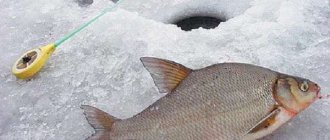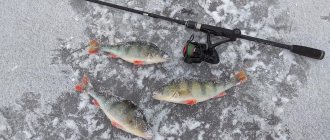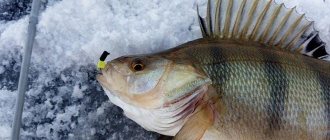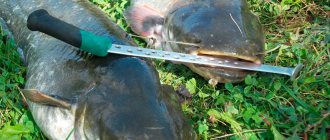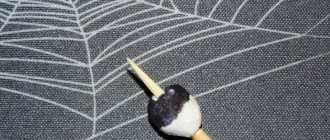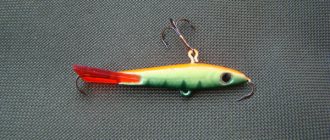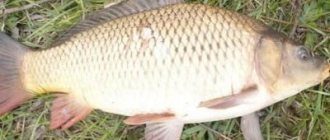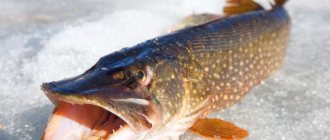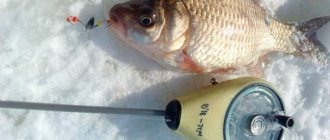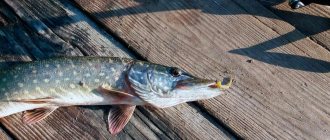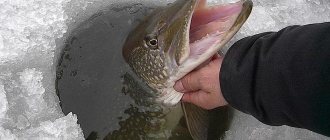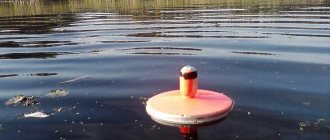A reelless jig or simply a reelless jig is a very catchy bait for winter fishing, invented by Russian fishermen in the 60s of the last century.
It is used for catching most species of carp, perch and medium-sized predators (pike perch, pike). The effectiveness of fishing with such bait depends on the correct choice of bait, tackle, and playing technique.
What is a reelless jig?
Bezmotylka (reelless jig) is a baitless bait for winter fishing, which is caught without the use of bait (bloodworms, burdock, maggots). The catchability of such jigs is explained by their active play and special animation techniques.
Like attachment models, such jigs are made from lead, tin-lead solder, and heavy refractory tungsten.
The difference between a regular jig and a reelless jig
The main differences between a reelless jig and a nozzle jig are as follows:
- The rewinder tied to the fishing line is positioned at an angle of 45-600. Thanks to this feature, when playing, it makes characteristic nodding movements that attract fish.
- On the hook of a rewinder there are always several colored beads, glass beads, cambrics, pieces of red woolen thread that imitate a nozzle and create additional sounds and vibrations during the game;
- In some models, the rigidly soldered single hook is replaced with a movable hanging double or tee hook;
- Compared to attachment models, they have an active high-frequency play;
On a jig without an attachment
I am grateful to roach for the fact that, having learned to catch it by playing, I now successfully use this technique when it comes to perch, bream with silver bream, ide, chub, bleak, dace, pike perch, pike, crucian carp and even carp. Over more than 20 years of such practice, with the participation of my like-minded friends, I managed to create several very catchy baits specifically “for roach”, which are now successfully used when hunting other fish. When fishing for roach, it is better to use baits whose bodies are painted black and dirty green.
Roach on a jig "Nymph"
The most tempting bait for the roach turned out to be the “nymph” jig, the prototype of which was the famous fly fishing lure. It was described in great detail in articles published in the magazines “Rybolov” No. 1 for 1995 and “Rybolov-Elite” No. 4 for 1995, therefore in Fig. 1 it is shown mounted with equipment, and the manufacturing technology itself is not given here .
Rice. 1 Equipment of the “nymph” jig:
1 - fishing line; 2 — hook ring; 3 - head; 4 — jig body; 5 - place for tying the fishing line; 6 — cambric “wing”; 7 — playing cambric; 8 - stopper, 9 - hook barb.
Initially, the “nymph” was equipped with playing cambrics. Now the development of “nymphs” is underway, which are tied in the same way as similar fly fishing lures, but only on a cast lead base. They are similar to the “nymph” in equipment and game of “butterfly” and “ant”, but they are much easier to make.
Mormyshka "Butterfly"
The sequence of making a butterfly jig is shown in Fig. 2. This requires thin brass, copper or bronze foil. A rectangular piece of it is bent in half and the “crown” of the future bait is cut out with scissors. Then the “wings” are spread 40-60 degrees, and the resulting cavity is treated with etched acid. A pre-bent, tinned hook, like for a “nymph”, is placed here; The cavity is filled with lead-tin solder using a soldering iron.
Fig.2. Sequence of making a butterfly jig:
a - fold the foil and mark a cutting line; b - spread the sides of the cut workpiece at an angle of 40-60 degrees; c - insert a tinned hook into the resulting cavity of the “crown” and use a soldering iron to fill it with lead-tin solder.
The hook of “roach” baits should not be larger than No. 14 (according to international numbering). Special hooks for tying flies with a medium-length fore-end and a ring bent inward are good for this - they almost do not need to be bent, but only slightly bent, increasing the distance from the tip to the fore-end.
Making an “ant” jig (Fig. 3) will require some shotgun shot of various numbers (No. 9-4). The shot contains antimony, so the bait will shine like the chitinous cover of insects. Two pellets, for example, No. 7 - head and No. 5 - body, are lightly cut on one side with a sharp knife, the cuts are treated with etched acid and the shank of a tin-plated hook is inserted into them. By combining pellets and hooks of different sizes, you can get a whole set of baits, each of which will give its own original game, allowing you to “pick up the keys” to difficult-to-take fish.
Fig.3. Mormyshka "ant": 1 - hook ring; 2 - large pellet (“body”); 3 — small pellet (“head”); 4 - soldering points.
On many reservoirs, especially on the last ice, large roach can be easily caught using the well-known “devil” bait. But, unlike similar decoys for bream, “devils” for roach should have a smaller ratio of the diameter of the body in the widest part to its length - no more than 1:4. The technology for making “devil” is quite complex, but at the Poultry Market you can pick up baits of any type, including tungsten ones.
For catching roach, “devils” whose bodies are painted black or green are suitable. The hooks of the bait are equipped with cambrics that slide freely along them: white is placed on one, black on the other, red on the third.
Personally, I never catch roach with the “devil” alone, but try to combine it with other elements of equipment to make the game more varied. I use three such combinations (Fig. 4, a, b, c): with a white or orange bead, freely “running” on the fishing line above the bait; with a lead pellet, also freely moving on the fishing line; with a hook 10-15 centimeters above the “devil”. The last option is the most catchy, so let’s look at it in more detail.
Fig.4. Devil equipment:
a - with a bead: 1 - fishing line; 2 - bead; 3 - “devil”. b- with a pellet: 1 - fishing line; 2 - lead pellet; 3 - “devil”. c - with hanging hook: 1 - fishing line; 2 - bead; 3 - hook; 4 — porous rubber ball; 5 - stopper; 6 - “devil”; 7 — playing cambrics; 8 — stop cambrics
In the fishing literature, there have been more than once publications about the advantages and disadvantages of an additional hook on a fishing line. The problem is that on thick ice, fishing often ends in failure, because one of the baits clings to its lower edge. In the option that I propose, there is no need to fear such a nuisance. I don’t tie the hook to the fishing line with a knot or on a leash, but put it on the fishing line through a ring and fix its “lower” position with a stopper made of thick black rubber. I “load” the hook on top with a yellow or white bead freely moving along the line if I’m fishing in still water, or with a lead shot if I’m fishing in the current.
Hooks No. 16-14 (according to international numbering) used for tying flies are suitable for roach. Such a hook has a ring bent inward, so it will stand perpendicular to the fishing line, and this is a necessary condition. I equip the hook with a ball of black porous rubber with a diameter of 2-3 millimeters or I wrap black or green thread around it to create a rounded thickening (I leave short “antennae” of the thread). For “suspension” I use a small fly fishing fly “nymph”, it also gives a good result.
The friction of the stop rubber on the fishing line after biting and hooking is quite enough for a good hook to detect a roach. When playing, it slides towards the “devil”, and the entire equipment passes through the hole as a single unit. Having removed the fish from the hook, I move the stopper to its original place. If the fish takes the bottom bait, then catching the hook on the ice will not interfere with fishing - as soon as the “devil” with the fish reaches the ice, the hook will unhook. It often happens when fishing that fish are caught on both baits at the same time.
If you install such a hook 30-40 centimeters above the perch spoon, you will see how the bite of not only these striped predators, but also medium and large roach, becomes more active; In addition, your prey can be silver bream, bream, and chub.
For stationary gear
When fishing with such gear, the hook of the bait must be skewered with something appetizing for the roach: bloodworms, maggots or burdock moth larva, or their combinations - “sandwiches”. In some places, roaches are successfully caught using raw flavored dough, pieces of rabbit lung, bark beetle larva, worm, and jig. The larvae of dragonflies, stoneflies and other living creatures that inhabit water bodies and are natural food for fish are also used.
Let me make a reservation right away that I consider catching roach with bait on a stationary tackle a necessary measure dictated by fishing conditions - mainly strong currents. On the Oka, Upper Volga and its tributaries, Pakhra, etc. (these are typical examples of fishing conditions) large roach stands on the fairway in winter along with bream, silver bream and ide. To hunt for these fish, the “Oka” jig (Fig. 5) and a leash with a jig above the sinker (Fig. 6) are successfully used.
Rice. 5. “Oka” jig:
1 - fishing line; 2 — bait body; 3 - hook.
Fig.6. Equipment for fishing in strong currents:
1 - fishing line; 2 — carabiner; 3 - leash; 4 - jig; 5 - sinker.
Outwardly simple in appearance, the “Oka” jig is well suited for fishing in strong currents, even for such cautious and “thievish” fish as roach. This bait is a lead or tungsten ball with a diameter of up to 10 millimeters. The hole for the fishing line and the shank of the hook are strictly perpendicular to each other, so the jig occupies a horizontal position on the fishing line.
The jig hook (No. 14-12) must have a long fore-end - the distance from the tip of the hook to the ball is not less than the diameter of the ball. The weight of the jig is selected so that it only “feels” the bottom - during fishing, the tackle is smoothly raised and lowered, while the jig seems to “walk” along the bottom. Naturally, the line has to be released downstream a little each time. The bite signal is a nod, the rigidity of which corresponds to the strength of the current. The bite usually occurs at the moment when the jig touches the bottom, or during a pause (5-10 seconds) between lifting the tackle.
It should be noted that such a large jig is catchable only during the period of good biting. When the fish activity is low, use a tackle with a leash. In strong currents, a pear-shaped end sinker weighing from 10 to 30 grams is effective. The leash is installed 10-15 centimeters above the sinker using the “loop-to-loop” method or using a carabiner. The length of the leash is up to 1.5 meters, it plays well in eddy currents.
So that in a strong current the leash reaches the bottom. At the end of it, a jig of the “Ural” or “ant” type weighing 0.2-0.4 grams is tied. The fishing technique is the same as with a tackle with a large jig, only the pauses between lifts are longer here (up to 30 seconds).
It will be interesting for you to try using a sinking fly fishing fly instead of a jig, appropriate for the season and used, of course, without an attachment. In moderate currents, the weight of the end sinker should not exceed 10 grams, the length of the leash should be 1 meter, and instead of a jig, tie a hook.
It happens that during the deep winter period, the equipment that is affectionately called “fool” by fishermen near Moscow turns out to be very productive when catching roach. It is used in still water or in reservoirs with very weak currents and is a “nod - sinker - hook” system. You can also use a float as a signaling device, the carrying capacity of which is strictly equal to the weight of the sinker (unfortunately, your observations will most likely be disturbed by the walking of other fishermen - their steps cause the ice to sway...).
The lighter the equipment, the more sensitive it is. Therefore, the weight of the sinker usually does not exceed 0.2-0.3 grams. The distance from the hook to the sinker is determined by the activity of the fish: the lower it is, the greater this distance is and ranges from 5 to 30 centimeters. Since 1-2 larvae of food bloodworms or burdock moths are often used as bait, it should be thin, perfectly sharp, and small in size (No. 18-16). In many reservoirs, roach, even in the dead of winter, is very well caught using a “fool”, if a small ball of semolina “chatter” flavored with anise oil is used as a bait. At the same time, the fish are fed with dry semolina - they pour it into the hole, it gradually gets wet and slowly sinks, attracting roaches.
How to choose a reelless jig?
When choosing a reelless reel for winter fishing, the following factors are taken into account:
- Winter fishing season - for the first and last ice, light and medium reelless lures of dull and dark colors (silver, black) are used. In the middle of winter, when fishing from the depths, medium and heavy baits of bright colors (golden, acid red, bronze) are used.
- Depth – at depths of up to 3 meters, jigs weighing no more than 0.1 are used; at medium depths (3-5 m) - 0.1-0.2 g. At depths over 5 meters, heavy baits weighing over 0.3 g will be more catchy.
- Weather - if the weather is sunny and clear, and the depth at the fishing spot is no more than 3-4 meters, then for such conditions black or silver reelless baits are used. On cloudy days at depths of more than 4 meters, on the contrary, more striking and larger baits of golden or bronze color are used.
- Object of fishing - small and medium-sized reelless baits of bright “tiger” colors (green or red with transverse stripes) are suitable for perch; roach responds better to silver and golden-colored baits; bream often takes medium and large black-colored baitless baits.
Let's celebrate! Also, in addition to these factors, they also take into account the professionalism of the fisherman, or rather, how “handed” he is - this makes it easier and more convenient for a beginner to master the basics of fishing with a reelless jig using medium and large jigs, which are easier to give the required frequency and amplitude of play than small ones. ultra-light baits weighing less than 0.1 g.
Fishing in the middle of winter
What fish is best to go for at this time? Just going fishing in the hope of catching something is a waste of time on a short winter day. Therefore, try to determine in advance which body of water you want to go to, what the fishing conditions are there, and what exactly you are going to catch. In accordance with this plan, prepare your gear.
The most common fish in most water bodies in central Russia are perch and roach. About the roach in “Fishes of Russia” L.P. Sabaneev wrote: “everywhere - both in Russia and Siberia - it constitutes the most numerous breed of fish, and there are few rivers where it does not make up the bulk of the entire fish population, especially since it was found would be very rare."
Large perch are well-known individualists; they form only small aggregations in their habitats. Hunting for it on the first thin ice, which does not require much physical effort from the fisherman, gives decent results. And catching small “sailor fish”, which also bite rather sluggishly in the middle of winter, is the lot of sports fishermen who hone their technical skills on them, which turns out to be practically useless when catching, for example, roach. This is evidenced by the following fact: when weighing the catches after the end of the competition, it turns out that they are 90, or even 100 percent, perch and ruff.
I remember how our team went to train in a reservoir where small roach, which was very active all winter, significantly prevailed over the same small perch. That training session ended in complete embarrassment: nearby, amateurs were dragging roaches out of the holes one by one, and the athletes just looked at them enviously... In the end, they found a perch in the shallow water - and “things” went well. I took out my “amateur” gear, and the roach began to peck vigorously in every hole.
This is just one of many examples confirming that the technical side of roach fishing has its own significant features, which depend on the activity of the fish, the type of reservoir, its depth, the presence and strength of the current, etc. I love catching roach from the ice, probably because no fishing experience is the same. Most often I fish with a jig without a bait, “for the game,” but there are other methods. Let's look at them in order.
The best types of rewinder
Banana
- A common borer, shaped like the same fruit.
- It is tied to the fishing line by the ring of a sharp single hook No. 18-20 protruding from the upper part of the bait’s body.
- Commercially available models of such bait weighing from 0.2-0.3 to 0.5-0.7 g can have different colors: silver, gold, copper, as well as bright monochromatic (acid green, red) or “striped” .
- Used for catching perch and roach at depths of up to 3-4 m.
Klopik
- A legendary baitless bait that has the asymmetrical shape of a ball truncated in half, a drop.
- The outer surface of the body is dark in color, and the inner surface, smooth or slightly convex, facing the tip of hook No. 16-18, is silvery and golden.
- Some models have a red eye painted on the inner surface using paint.
- In most cases, small-sized Klopiki are made of heavy tungsten and weigh 0.5-0.6 g, thanks to which they can be used for fishing at various depths.
Goat
- A tungsten baitless bait, reminiscent in shape of Uralka, weighing 0.15-0.3 g, with a small double No. 17 rigidly sealed into the body.
- Available in classic colors - gold, silver, copper, black.
- The Koza is used for catching large roach and perch throughout the ice fishing season.
Ant
- The bait is shaped like the body of the insect of the same name.
- Its body weighing 0.2-0.3 g consists of 2-3 spherical sections of different diameters.
- Available in traditional gold, silver and copper colors, equipped with a single hook No. 18-20 with a long shank.
- Used for catching large roach and bream.
Fly
- Tungsten baitless bait weighing 0.2-0.3 g in body shape resembling a small fly without wings: it has two small spherical sections (head and chest) and one posterior ovoid, pointed (abdomen).
- Various models have 5 classic colors: gold, silver, nickel, copper, black.
- The jig is equipped with a sharp hook with a long shank No. 18-20
- During the winter season, large roach, bream, and trophy perch are caught with it.
Nymph
- A baitless jig that has a body resembling an insect larva and consisting of a small head and an elongated belly, ending with a sharp single hook No. 18-20.
- On sale, the Nymph is found in both simple solid colors (golden, copper, silver, black), and in brighter and more complex colors (green, red, yellow with transverse stripes, etc.).
- Mainly bream, large and medium roach are caught with this bait.
Uralka
- This is one of the most popular and catchy models, having the shape of a curved elongated drop.
- Equipped with a sharp single hook No. 16-18.
- The most catchy baits of this type are models of silver, black or golden color.
- Thanks to the variety of models of different weights (from 0.3 to 0.6), Uralka is used both for fishing for medium and small perch in the coastal zone, and for deep bream fishing in pits.
Devil
A tungsten or lead no-attachment jig suspended strictly vertically with a drop- or stick-shaped body of silver, golden or black color, a rigidly soldered or suspended tee in the lower part. Widely used for winter trophy fishing for large perch, roach, bream.
A variety of jigs
The most popular reelless jig can be considered a vertical jig in the shape of a devil. A fishing line is tied inside the body-post, and at the bottom of the post there is a treble hook. Also suitable for winter reelless fishing is a jig in the shape of a perch’s eye. This is a small golden ball that has a drawn eye.
This rewinder has one hook. The shape of the ant on the mothless fish really attracts fish. These are two balls of different sizes that are soldered to each other. There is a hook on the small ball at the bottom. A common jig can be considered the shape of a bulldozer.
This is a reelless fish that has a conical body, and the attached hooks can move along the fishing line. Rewinders of different shapes attract fish and activate their activity. When purchasing catchy reelless reels, you don’t have to worry that there won’t be a catch. With the help of such gear you can catch the following types of river inhabitants: white bream;
- Perch.
- Pike.
- Pike perch.
- Bream.
- Roach.
- Guster.
- Bleak.
- Sopu.
Winter fish is beautiful in appearance and appetizing in any form prepared. Its meat is not bony. That is why in winter you can meet fishermen on various bodies of water with the aim of fishing for a reelless fish. Having chosen your fishing tactics (preparation of gear, choice of location, availability of bait), you can begin the long-awaited process of fishing.
How to choose the time and place for winter fishing for reelless?
For successful fishing with baitless baits, it is very important to choose the right time and place of fishing:
- With constant or slightly changing atmospheric pressure and weather over several days, the bite on a reelless jig is most active during the day in the morning (from 8 to 10) and evening (from 15 to 16-17.00).
- The most promising places throughout the winter fishing season for the angler without a moth are various anomalies of the bottom topography (pits, mounds), flooded snags, bushes, shallow areas bordering the depths, dumps and edges of holes, windows in coastal reed thickets.
Note! You can find the most promising fish accumulation points in an unfamiliar body of water using a winter echo sounder.
What kind of fish should I catch in winter using a reelless bait?
The following types of fish are caught using a reelless bait:
- Perch;
- Ruff;
- Gudgeon;
- Roach;
- Guster;
- Bream;
- Zander;
- Pike.
Also, in some stagnant reservoirs, large crucian carp and carp can be caught with a reelless bait.
Advantages of a rewinder
Reelless fishing is very different from fishing using natural bait or bait. In the first case, the jig seduces the fish due to its game, appearance, vibrations and other factors affecting the senses of representatives of the ichthyofauna. In the second, the main task of the bait is to deliver the bait to the fishing point. The game itself and appearance are of secondary importance.
A classic equipped reelless fishing rod that is suitable for any beginner
The main advantages that a reelless reel provides to anglers are:
- efficiency throughout the winter;
- a huge variety of jigs and options for their equipment;
- the ability to use various fishing techniques;
- works on all bodies of water;
- allows you to target large fish;
- relative cheapness of gear (many elements can be easily made independently).
One of the disadvantages is the difficulty of fishing. The fisherman must have a good grasp of fishing techniques, imagine the behavior of the jig in the water, adapt to the mood of the predator, and be able to use different techniques for animating the bait.
Choosing gear for a rewinder
For winter fishing for reelless fish, use special light tackle weighing from 1.5 to 5-7 g, consisting of:
- Winter fishing rod of the “puck” type, consisting of a cylindrical foam body with a groove for winding fishing line and a short, flexible whip inserted into the side;
- Fluorocarbon winter fishing line with a cross section of 0.06 -0.12 mm;
- A caprolavsan or metal thin nod 10-15 cm long.
Good to know! This kind of tackle, compared to the usual “balalaika”, will allow you to give the bait the highest possible oscillation frequency, without tiring your hand and feeling not only the play of the jig, but also the bite of the fish.
Main features of jigs for catching pike perch
Winter jigs for pike perch are presented in huge quantities on the market. They differ in size, color, weight, and material. To choose the best jigs for pike perch for winter fishing, you need to know the criteria for catching models.
Color spectrum
A jig for pike perch in winter can be of any color; there is no consensus among ice fishermen on this matter. But there are certain recommendations that allow you to choose an effective option:
- Luminous baits. Considering that pike perch is at great depths in winter, you can attract its attention with jigs that emit light - phosphorus. They work great in the evening and until midnight, when predator activity is at its highest. These models can also be used early in the morning.
- The baits are as realistic as possible, imitating the usual food of a predator. These are fish fry, pike perch adores them. Narrow-bodied organisms fit into the special mouth of a fanged robber. Silver baits are highly effective here.
- Presence of shine on the jig. The predator is quite curious; it can easily be interested in baits with glitter on the body. They are clearly visible on sunny days, even from long distances.
Size and weight
When fishing from ice, pike perch jigs should be small, 15 mm. If the reservoir contains mostly medium-sized individuals and perches, then baits 10–12 mm long are suitable. But in open water, in the summer, versions with a length of 20 mm work great.
Winter fishing for pike perch with a jig will be much more effective if you choose light products weighing 15 g. But there are anglers who prefer to use heavier baits. Heavy jigs are better suited for hunting in strong currents or in areas with impressive depth. Their weight is often 30 g. It is worth using jigs weighing 15 g on reservoirs with moderate currents and slow rivers.
Winter fishing with a reelless - fishing technique
Basic playing technique
The simplest, yet most effective technique for playing with a reelless winter jig consists of the following techniques:
- The fishing rod, clamped in the working hand, is located almost at a right angle to the plane of the ice. The fishing line is released from the tackle chute when the fishing rod bends until the nod straightens (the jig falls to the bottom).
- After the bottom is found and the extra line is wound around the fishing rod, the hand holding it relaxes and straightens at the elbow;
- Lifting with high-frequency vibrations is carried out by a kind of trembling of the entire relaxed arm, and not the hand or wrist;
- In the process of rising to a height of 70-100 cm above the bottom, perform 2-3 pauses lasting 1-3 seconds every 20-25 cm;
- At the highest point, a control sharp hook is performed, after which the bait is lowered to the bottom and the wiring is repeated again.
With this technique, 5-6 lifts are made on 1 hole and if there are no bites, they move on to the next one.
Special Animation Techniques
In addition to the basic technique of playing with a reelless reel, during the fishing process it is also used such special animation techniques as:
- Reverse retrieving - after the bait has reached its highest point during the basic retrieving, it is smoothly, giving vibrations of different frequencies, lowered back to the bottom, making pauses every 20-30 cm of descent as when lifting;
- Lifting without hesitation is the simplest, but often effective maneuver, consisting of slowly lifting the jig without giving it vibration;
- “Tapping on the bottom” - this technique, widely used in fishing with jigs, consists of sharply lowering the bait to the bottom 2-3 times to raise a cloud of turbidity, which attracts nearby fish.
- “Hovering above the bottom” - this technique is used in conjunction with the previous one. Its essence is that after several strikes of the bait on the bottom soil, it is raised above it by 5-10 cm and left to hang motionless for some time (up to 1 minute).
Hooking and landing
Since jigs are used in winter and the fishing line is thin, the hook when fishing with reelless baits is short and sharp. If the fish is hooked, the fishing rod is thrown to the side and, picking up the fishing line with your hands, they carefully pull the prey to the hole.
When pulling a fish out of a hole, the fishing line must be kept perpendicular to the surface of the water (sludge) in it - this will prevent excessive friction of the fishing line against the edges of the hole and reduce the likelihood of injury.
Shape and color of jigs
The most used one is the drop jig, which is in the arsenal of any fisherman.
Next comes Uralka . Why is she Uralka? This model came from the north. Such forms, especially large ones, behave well in currents. They, let’s say, become with the flow and stretch out. The ball is one of the most practical. Washer with an eye . You can fish with a puck with an eye even without a nozzle. The eye may be red, or sometimes shiny (pictured below). To a fish, it resembles a perch's eye.
with a puck while standing. Those. it lies on the bottom, and, for example, for catching bream or roach, i.e. For those fish that like to peck from the bottom, this is very important.
There are original forms of jigs, for example nymph . The jig is unique. It has its own game, and not one that only you can give. And also behaves quite well. Whitefish and grayling respond well to it. Their diet consists of crustaceans that resemble this jig.
When catching roach in winter, use the following types of reelless gear:
Features and nuances of fishing with a reelless reel
Compared to baited analogues, fishing with reelless reels has the following features:
- At the hole, the fisherman begins to drill from the shore and towards the center of the reservoir in large increments of 8-10 meters.
- If a bite occurs in a hole or a fish is caught, the area around it is drilled in 4 directions in a “cross” pattern, making 4 more holes perpendicular to it;
- During the fishing process, the angler experiments, very often changing baits and playing techniques. This is necessary in order to select the most suitable reelless reel for specific fishing conditions and play with it.
- Promising holes in which fish were caught, but the bite then stopped, are fed with a pinch of bloodworms, marked with a twig or reed stalk, in order to return after a while and re-fish them.
Top 5 catchable rewinders
A short review of jigs that can be used to fish without bloodworms.
The order of jigs in the list is random and is not related to their catchability
, since this is a very subjective parameter and depends on many factors:
- fishing experience;
- type of fish and its activity;
- place, time and fishing conditions.
Let's move on to the review. The best jigs for catching perch, roach, bream and other fish without bloodworms:
#1 Devil or devil
This is a drop-shaped jig with three soldered hooks. Most often it is black in color. When they say “damn”, they usually mean a fairly large jig. Devils are smaller baits.
Tips for fisherman: Winter fishing rods for trolling on aliexpress - Tips for a beginner
One of the working retrieves is to slowly raise the bait to hand height while simultaneously working with a nod, which gives it high-frequency swaying. This is followed by dropping the bait to the bottom or slowly lowering it while playing with a nod.
#2 Nail ball and nail cube
If you hang a metal ball or cube on the fore-end of the hook of a nail-type jig, it becomes a “nail ball” or a “nail cube,” respectively.
This rewinder is quite simple to make:
A slot is made in a piece of tin, lead, brass or tungsten wire for the hook, which is then sealed. Metal balls can be taken from kits for creating spinners.
#3 Goat or little goat
By analogy with “devils,” fairly large jigs are called “goat,” and small jigs are called “goat.”
Small “goats” are often used as additional jigs tied above the main one in “garland” or “locomotive” type rigs.
#4 Uralka or Uralochka
Ural jigs are legendary baits. In the hands of an experienced fisherman, a tackle equipped with such a jig can compete with any other.
There are no strictly defined proportions of jigs. There are shortened and elongated “Uralkas”.
On the shelves of fishing stores there are mainly cast tin lead jigs, but you can also find turned ones made of tungsten.
The most common color options are black and silver.
#5 Grader
This jig is a bit like a “devil”. It has a volumetric teardrop shape and a hanging tee. The catchability of the bait increases if the tee is equipped with a droplet or other “decoration” options.
Unlike the reelless jigs described above, the wiring of this jig can be similar to trolling or playing with a “buldo” - a short jerk and release. In combination with classic fishing, fishing with a grader can be very productive.
Weighty baits of this type allow you to catch large perch at great depths.
PS
To successfully fish with reelless lures, you need to be able to give the bait a special game that provokes the fish to bite. For many small jigs, this is high-frequency vibration with low amplitude. But in fishing there are sometimes exceptions, because a lot depends on the fishing conditions.
No tail, no scales.
Subscribe to
fishing subtleties , put See you again!
The advantages of Tactic No. 2 include checking more places on the reservoir for active biting, and the disadvantages are the need to drill a lot, especially when the ice is already half a meter thick.
Reviews from fishermen
I tried fishing with reelless baits several times, but it didn’t work. He quickly switched to baited jigs with the addition of moths and burdocks. The fishing method is undoubtedly interesting, but more suitable for patient and meticulous fishermen. Grade:
Sergey
I’ve been fishing in the winter for about 10 years now, and for most of that time I’ve been using exclusively reelless baits. Although fishing with them requires more effort and patience than with simple baits, it pays off with decent catches. I recommend it to all lazy fishermen!!!! Grade:
Oleg
For 2 years I have been fishing in winter exclusively in Uralka and Chertik. Other jigs are just gathering dust in a box - I only use them for stand-up jigs and floats. And with these two jigs I catch all the fish - from sailor perch to large bream. I recommend it to all lovers of ice fishing. Grade:
Alexander
I started with baited jigs a couple of years ago, but then I mastered reelless jigs and forgot what it was like to run like a stung person before fishing around the city and looking for scarce bloodworms. I have a large arsenal of no-bait baits, ranging from small ones (about the size of a match head) to weighty and large ones, more like small bottom spoons. I recommend this method of fishing to everyone - from beginners to old-timers! Grade:
Pasha
My winter fishing has been associated with reelless fishing for several years now. I switched to it from a winter float and a simple jig. And since then I have never regretted it - although I often have to trample a single kilometer on the ice, the catch is many times larger and better than that of those who sit on the feeding grounds. In my opinion, this kind of fishing is the most interesting and exciting. Grade:
Ivan Ivanovich
Note! Fishing with baitless jigs is an active type of winter fishing that allows you to find and force fish to bite not only during periods of high activity, but also in the middle of winter. At the same time, the weight and quality of the catch of those without moths is most often higher and better than that of their less diligent and patient colleagues who use baited analogues.
Types of jigs
An experienced fisherman keeps different types of jigs in a box.
Summer and winter baits
Summer and winter baits differ in weight. In summer, the upper layers of the reservoir are filled with fry, which attack any bait, which means they do not allow it to reach the bottom, where large fish swim. To protect the bait, summer jigs are made heavier than winter models.
In summer, the water in the reservoir is more cloudy, so the color of the jig should be brighter.
The winter jig is smaller in size than the summer bait. This is necessary so that the bait looks more believable in clear water.
Moths and mothless
Bloodworm is the most catchy bait. This bait is very delicate, which means it is not difficult for the fish to knock it off the hook. Experienced fishermen start fishing with reelless reels and then switch to baits.
Mothless fish resemble insects that are part of the fish’s diet, so it bites without fear. For better attractiveness, the bait is decorated with shiny threads. In some cases, sprays with a special aroma are used. Moths with an animal bait increase the chance of a bite, since fish have a well-developed sense of smell.
Form
The behavior of the bait depends on the shape if there is a current or standing water. A jig with a teardrop shape when retrieved imitates an insect caught in the water. This bait is usually attacked by perch and ide.
The flattened jig resembles a butterfly. When wiring near the bottom, a cloudy cloud is created. It attracts curious fish.
Weight
Since reservoirs come in different depths and with different current intensities, baits are needed that will have different weights. They are made light, medium weight and heavy.
Cargo material
To make the bait sink faster to the set depth, it is made heavier. Tin, lead, and tungsten are used as weighting materials.
Color
To make the jig attractive for winter fishing, it is painted in different colors. Due to refraction in the water column, the color of the bait changes. At great depths, red and yellow colors are clearly distinguishable. Each type of fish has colors associated with food. For example, roaches have black, white and orange colors. Predatory fish are attracted to black, red and yellow colors.
Hooks
Jigs use from one to three hooks. Thin hooks have advantages, but they cut the fish’s lips and the catch is lost. In a standard jig, the forearm and sting form one plane, but a hook with a bent sting is needed for predatory fish.
A jig with a nozzle should have a long fore-end to better hold the bloodworm.
Fishing technique and tactics
In terms of technique and tactics, fishing with a mothless fish differs significantly from fishing using bloodworms or other bait. It involves active movement around the water area, continuous search for fish, selection of the optimal jig and retrieve.
Depending on who is being fished, it is necessary to change search tactics, jigs and their animation. In addition, the choice of technique and tactics is influenced by the weather and fishing time. For example, fishing on the first ice is very different from reeling in February.
Perch fishing
Fishing for perch with a reelless reel in winter has many fans. In terms of effectiveness, this direction competes with vertical spinners and balancers, and allows you to successfully hunt for the striped robber all winter on any bodies of water (from the endless expanses of reservoirs to small toad grasses and ponds).
Perch is the main object of fishing for any fishermen
The best jigs for perch are:
- Uralka,
- pellet,
- ant,
- a drop.
These lures love high-frequency action called "dribbling" or "shaking"
Available underwater footage, which is easy to find on the Internet, shows that active and noisy fuss attracts the attention of the striped robber, can attract passive fish, and can gather a large number of predators at the hole
A reelless reel for perch is a formidable weapon in the hands of a seasoned “penguin”. By using large jigs, you can effectively catch a heavy predator. Often trophy specimens fly in, which are not always ready to attack the spoon, preferring smaller, but no less appetizing baitless ones.
On the first ice
The beginning of winter is the most favorable time for hunting the striped robber with a rewinder. At this time, the predator behaves actively, quickly attacks the offered bait, and is not capricious. It is on the first ice that it is recommended to start mastering fishing with a baitless jig, since not catching a fish during this period is more difficult than getting it to sit on the hook.
The best jigs for first ice are Uralka, Ant, and pellet. They respond to fast play, collect fish well to the hole, and seduce perch of various sizes. For targeted fishing of a heavy predator, it is recommended to use a banana or a goat.
On first ice, you can’t stay too long on one hole. You have to constantly move around the water area, drill into the ice and look for perch. As a rule, it is enough to make a few lifts of the jig to determine the presence of fish and its mood. If there are no bites or a small perch takes it, then you need to change the point and continue the search.
Bream fishing
Bream is a difficult fish to fish for, since it inhabits mainly deep areas of water bodies and loves currents. It is not easy to use a jig in such conditions, but this fact does not stop experienced fishermen who know how to find an approach in the current situation.
Bream requires large, heavy jigs
Catching bream involves using heavy jigs. As a rule, uralks and large pellets made of tungsten, less often lead, are used. A separate category is devils. They can be used individually or several at a time. This direction of winter fishing is called “garland” and allows you to quickly fish all horizons in deep areas of reservoirs.
Advice! It will be difficult for a beginner to master catching bream on his own using a reelless reel. It's better to take lessons from professionals.
Bream loves a calm, smooth game. Sometimes it is enough just to slowly raise or lower the jig so that the fish reacts to it. It is advisable to take pauses, the duration of which can range from a second to ten.
Roach fishing
The roach responds very well to the rewinder. This is confirmed by the large number of fans of its fishing without bait and impressive results, especially when purposefully hunting for medium and large specimens.
Roach can be caught well with a “naked” jig
Reelless fishing works well on the first and last ice. The best jigs for fishing for roach are:
- nymph;
- oatmeal;
- banana;
- pellet.
Roaches love black and brightly colored baits. Responds to different games. Active fish greedily attack fast, noisy objects. Passive individuals are wary of “buzzing” jigs, but they are not averse to catching prey making smooth, unhurried movements.
Roach, like no one else, loves the various additional elements that are equipped with nozzle jigs. These can be banal beads and cambrics, as well as chains, discs, wings, threads, lurex, etc. Anglers need to constantly experiment, choosing the optimal combination.
